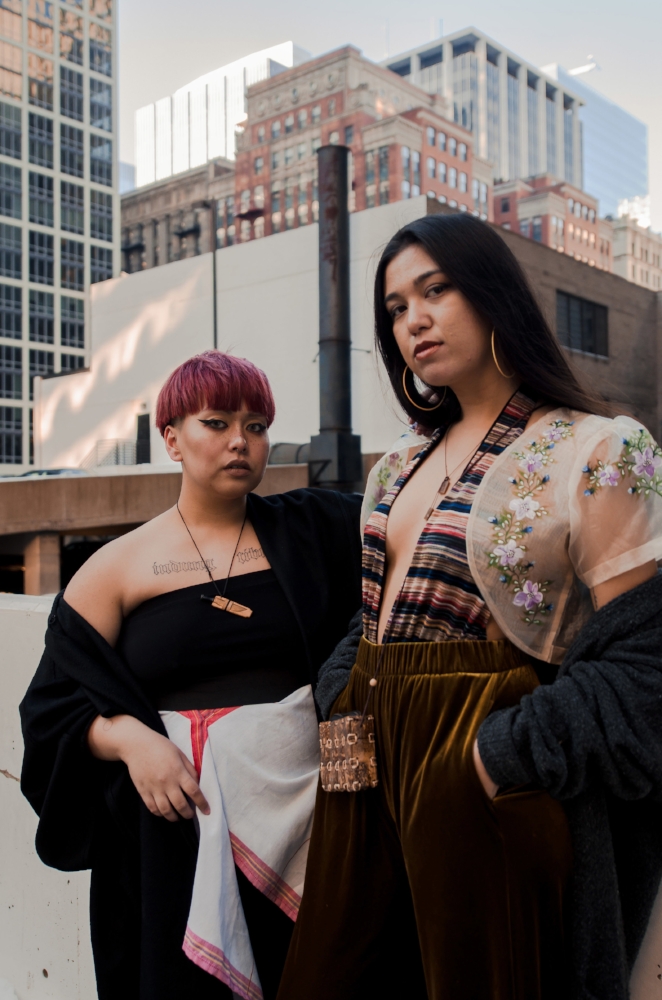Acclimate Not Assimilate: Chicago Winter Filipina Streetwear
Words and images by Mikayla Delson. The full series will be featured in Surat Magazine, the first magazine to be written in all pre-Philippine script in over 50 years. Follow Mikayla's work on Instagram @swipernoswiping_ and at http://www.mikayladelsonphotography.com/
I am a Filipino American. My mom was born in The States and my dad came here from Bontoc, Philippines when he was four years old, only knowing his native language, Kanakaney. My father always told my family and me stories of his childhood, many were of his life assimilating in America. When he was in school, he had a hard time learning English, so his teachers told my grandparents to stop speaking his native tongue at home. Soon, him and his siblings only knew English. When immigrating to America, so much of our Filipino identity is lost. Many face discrimination, and were either forced to or wanted to assimilate into American culture, losing our identities of being a Filipino. For a myriad of reasons first generation migrants may be either unable or unwilling to continue these traditions onto their children. Such reasons could be traumas associated with migration, war, colonialism/colonial mentality, socioeconomic factors, and more. With that, we forget the histories, language, and traditions; we even dress and look differently to assimilate. Since colonization, we’ve had parts of our culture taken away, with many arts practices on the edge of extinction.
Today, many Filipinos grow up in America knowing more about American culture than their own Filipino culture. I meet many Filipino Americans that do not see the value of keeping their Filipino culture alive. Maybe it is there, but it could be overshadowed by other things, or maybe their latent desire remains unsparked because of the lack of cohesive communities and community resources. I am like many Filipinos Americans in Chicago that did not grow up around other Filipinos. Growing up, there were such a lack of other Filipino students and faculty in my schools that I would often think of myself as “just Asian”, and I was even told by Filipinos that I am “not Filipino enough” because I don’t speak Tagalog. Because of these and many other reasons, people in my generation often feel lost and question their roots and identity. It wasn’t until my late high school years, where I became prideful of who I was. Although my parents are Americanized, my dad was very connected to our Igorot heritage. I was not just proud of being a Filipina, I was proud to be Igorotak.
I want to encourage young people like me to really dig into their family’s heritage and to proudly wear it on their sleeves. Just as my dad would wear a bahag, when all the other Filipino men wore barongs. I am one of many Filipinos in my generation wanting to reclaim our roots, and to continue cultural practices and teachings that were previously lost. This photo series seeks to honor our ancestors and to reclaim the significance of traditional, cultural attire by incorporating such pieces with our everyday wear. I want to normalize the act of wearing our peoples’ clothing, without being seen as a “costume” or something that is only to be worn for a Filipino-specific celebration, and to continue the practice of wearing and passing down our families’ clothing, a piece of our own history. The Pinays in this project show that our islander clothing can still be worn in Chicago’s very cold winter. For those of us who often feel as though we are caught between cultural identities - that of our ancestors and that which we currently live in - doing so demonstrates embracing our roots, being proud of where we came from, and ultimately, the importance of hanging onto, celebrating and propagating our families’ cultures.










